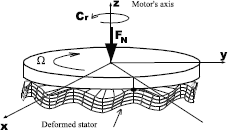Chapter 10
Control of Piezoelectric Actuators 1
10.1. Introduction
10.1.1. Traveling wave ultrasonic motors: technology and usage
Traveling wave ultrasonic motors make use of the mechanical vibration of a stator to drive – by friction – a rotor, strongly, which is held against the stator [SAS 93]. The vibration is obtained by the excitation of small piezoelectric elements which deform under the action of a transverse electric field. Figure 10.1 shows a diagram of the piezoelectric motor on which the deformations of the stator are exaggerated.
Figure 10.1. Principle of functioning of a traveling wave ultrasonic motor

Traveling wave piezoelectric motors are considered to be 2-phase motors which are supplied with two alternating sinusoidal voltages and are referred to as ![]() and
and ![]() . Under the inverse piezoelectric effect, the electric field generates in the exciters’ deformations; for each voltage considered independently, a standing deformation wave is established which is combined with the other to propagate a traveling wave. It is this traveling wave which seems to rotate around the axis of the motor that allows the generation of torque.
. Under the inverse piezoelectric effect, the electric field generates in the exciters’ deformations; for each voltage considered independently, a standing deformation wave is established which is combined with the other to propagate a traveling wave. It is this traveling wave which seems to rotate around the axis of the motor that allows the generation of torque.
Thus, contrary to electromagnetic motors, the ...
Get Control of Non-conventional Synchronous Motors now with the O’Reilly learning platform.
O’Reilly members experience books, live events, courses curated by job role, and more from O’Reilly and nearly 200 top publishers.

